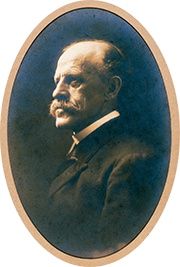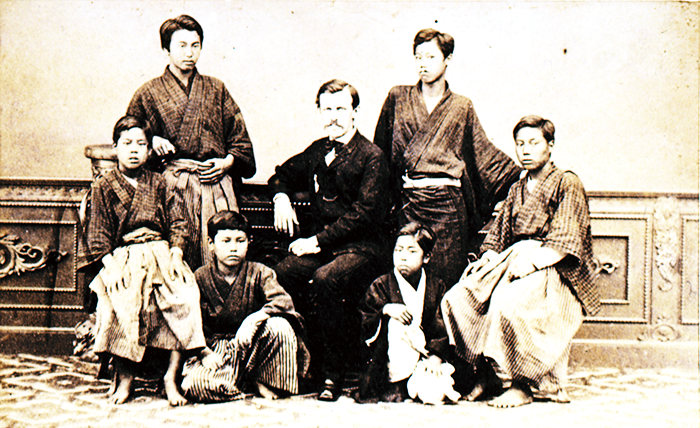William Elliot Griffis

福井市立郷土歴史博物館蔵 William E. Griffis
The late 19th century was a time of great change for both Japan and the rest of the world. The arrival of Commodore Matthew C. Perry in 1853 ended two hundred and fifty years of isolation, thrusting Japan into an increasingly dynamic, interconnected, and occasionally hostile world. In order to compete in this new world, many centuries of tradition were put aside, institutions were dismantled, and Japan was restructured into a modern nation-state. One of the most significant developments came in education, particularly in the sciences, which were seen as fundamental to furthering Japan's security and industrial development.
Just prior to the Meiji Restoration of 1868, the Fukui Domain sent a brilliant student, Taro Kusakabe, to study Mathematics at Rutgers College (now Rutgers University) in the State of New Jersey. There he met and befriended William Elliott Griffis, who tutored him in Latin. Ever the diligent student, Kusakabe was at the top of his class. Unfortunately, he dedicated far more attention to his studies than to his health, and he died of tuberculosis on April 13th, 1870, just weeks before graduation.
Later that same year, Griffis was hired by the Fukui Domain to teach the sciences to young students at the recently established Hankou (Domain School). Motivated by both an avid curiosity for the Far East and Japan, as well as the financial need to support his family in Philadelphia, Griffis accepted the position, arriving in Fukui on March 4th, 1871.
Dedicated to being an influential force in the modernization of Japan, Griffis went far beyond his contract to educate the students of Fukui and help establish a modern educational system. His dedication earned him the respect of Fukui’s leaders and influential samurai, befriending the likes of Kimimasa Yuri, who had been the first minister of finance and would become a governor of Tokyo, the newly established capital.
His dedication to work was only matched by his curiosity for a new land, and he spent much of his free time traveling around the Fukui countryside. This time spent in Fukui was also marked by one of the most important events in modern Japanese history, haihan-chiken--the abolishing of the han (domains) and the establishment of the contemporary ken (prefectures). Feudal lords were replaced by governors, castles were dismantled, the samurai chaste system was broken down, and education was opened to the general public.
Witnessing these events firsthand, Griffis gained great insight into the essence of Japanese history and tradition. These insights would contribute to his most famous work, The Mikado’s Empire (1876), a historical narrative of Japanese history from ancient times to 1872 AD. Having recorded much of what he witnessed during his time in Fukui, the book offers a rare firsthand account of haihan-chiken and other rapid changes of the early 1870s. Griffis himself strongly supported the abolition of the Domain System and the centralization of authority. However, this would also be his motivation for departing from Fukui, along with many of his best students, to Tokyo, the new seat of power. Though his time in Fukui was brief, his contributions to the development of Fukui education are highly regarded by local residents to this day.
After spending two and a half years teaching at the precursor to Tokyo University, Griffis returned home to the United States to become a formally ordained minister. After attending Union Theological Seminary in New York City, he was called to the ministry in Schenectady, New York, and Boston, Massachusetts. After many years serving as a minister, Griffis, at the age of 60, decided to dedicate the remainder of his life to writing and lecturing. Japan was the main focus of his literary efforts; however, his works also include a history of Korea, China, and Holland, as well as collections of European, Korean, and Japanese fairy tales.
Griffis would become the preeminent Japanologist of the time, giving lectures across the United States and Europe. Griffis was invited to return to Japan in late 1926 to accept the Order of the Rising Sun, 3rd Class. He and his wife Sarah travelled across the country for months in a private train car provided by the Japanese government. He marveled at the extent to which Japan had modernized since the 1870s; it was indeed the product of a seed that he had helped plant so many years ago. He returned to Fukui in late April, 1927, where he was met with a hero’s welcome. After returning to the United States, he passed away on February 5th, 1928 at his winter home in Florida.
Griffis did not live to see the deterioration of American-Japanese relations in the 1930s and 1940s. But despite all that has happened in the last century, the memory of Griffis remains strong in Fukui. This museum is a manifestation of the respect and appreciation for his contributions to Fukui and Japan.

Griffis and his Students